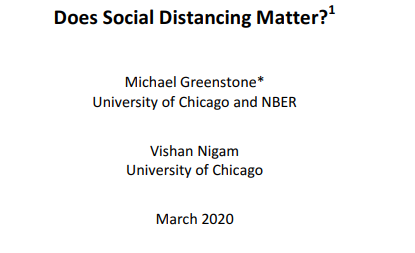ProMarket reviews the most recent and interesting academic papers on the ongoing pandemic: Michael Greenstone and Vishan Nigam of the University of Chicago estimate that social distancing in the US could save 1.7 million lives, compared to a “no policy” scenario, since it would lead to 630,000 fewer fatalities from hospital congestion and 1.13 million fewer deaths of hospitalized Covid-19 patients.

Editor’s note: if you have an economics paper on Covid-19 and would like to have it on ProMarket, please send it to ProMarket@ChicagoBooth.edu with a 500-1000 words summary presenting it to a general audience.
What share of GDP should the US be willing to give up in order to avoid an increased risk of death due to Covid-19, especially among seniors and other more susceptible populations? Recent discussions about shutting down various parts of the US economy in order to curb the transmission of Covid-19 have centered on the proper method for, and even use of, cost-benefit analysis.
While criticisms of such analysis pertaining to its incompleteness along various dimensions that certainly deserve consideration commensurate to their degree of importance in the overall evaluation of a human life, such shortcomings should not become a preoccupation to the extent that it obscures the merits of cost-benefit analysis as one input when trying to answer a question of this nature.
On the cost side of things, we should be clear about the various possible meanings of phrases that are commonly thrown around unexplained.
While a “shutdown” would affect most of the US economy, sectors will likely vary widely in the extent to which they will continue to operate in such a scenario. For example, while the travel, tourism, entertainment, and hospitality industries are almost completely or wholly shut down, retail stores (like supermarkets) and health care facilities would continue to provide vital supplies and services.
On the other end of the spectrum, sectors like software and telecommunications could see even smaller contractions. Therefore, it is better to talk about large reductions in economic activity, rather than a complete shutdown.
Quantifying the benefits of reductions in economic activity requires a metric that puts a reasonable number on the value of human life saved. A common way economists and policymakers attempt to monetize the value of human life is by calculating the “value of a statistical life”.
Imagine a population of 10,000 janitors having the option to be employed at either a public high school or a nuclear power plant, and we observe that these janitors are willing to accept the latter job, which is paired with an increased fatality risk of 1 per 10,000 if they are paid $1,000 a year more in wages. Then, collectively, this occupational group values the chance of one additional (statistical) death among them at 10,000 times $1,000, or $10 million.
Economists estimate the average value of human life across a spectrum of occupations within various industries by observing the risks and wages associated with these occupations, controlling for factors that determine wages other than fatality risk.
Given Covid-19’s high average age of infected individuals (about 59 in Mainland China) and even larger skew towards seniors in mortality, it is worth considering possible adjustments of the value of life with age.
In a paper published last month, Michael Greenstone and Vishan Nigam of the University of Chicago estimate that social distancing in the US could save 1.7 million lives compared to a “no policy” scenario, since it would lead to 630,000 fewer fatalities from hospital congestion and 1.13 million fewer deaths of hospitalized Covid-19 patients. Greenstone and Nigam base their analysis on an Imperial College simulation of the virus’ spread and mortality.
To monetize this reduction using a separate value of a statistical life for each age bracket, they then distribute this fatality reduction across nine age categories between ages 0 and 80+. They find a benefit of $7.9 trillion dollars, over a third of the US GDP in 2019, but less than 40 percent of those benefits accrue to people over 70, despite these individuals accounting for two-thirds of prevented fatalities.
The reason for this is the heavy discount Greenstone and Nigam apply to the value of a statistical life for people over 70. For example, while they value the statistical life of an individual between ages 30 and 39 at $15.8 million, a statistical life between the ages of 70 and 79 only weighs in at $3.7 million.
This is a heavy discount to be sure, but remember that we observe a rapidly declining number of the labor market transactions that value the statistical life calculations are usually based on for individuals over the age of 60, which significantly complicates coming up with an age-consistent estimate.
Instead of relying on the usual method outlined above, which infers the value of life from the tradeoff people make between their risk of death and the level of their wages when considering certain risky jobs, Greenstone and Nigam take a different approach that is perhaps better suited to computing the value of life across a wide age range.
They choose to follow a 2006 study by Kevin Murphy and Robert Topel of the University of Chicago that models the value of life as a function of consumption and income, both of which vary with age. More specifically, consistent with evidence on variation in consumption over an individual’s lifetime, as a person’s health at a particular age amplifies the value of that individual’s consumption and leisure time, consumption falls at older ages with declining health setting in from roughly the age of 40.
Using this approach, Greenstone and Nigam find that the value of remaining life peaks around age 30 at $16.1 million, declining to $1.5 million for the 80+ category, mostly due to mortality rates and declines in remaining life consumption value.
While a 90 percent reduction in life value for an 85-year-old compared to a 30-year-old appears devoid of humanity, remember to see cost-benefit analysis only for what it is: a lower bound on value lost, and if this already suggests large reductions in economic activity are worthwhile, then this would compel serious consideration of such policy options.
Conversely, if a cost-benefit analysis would imply that saving lives is not worth the economic cost of doing so, then this would not necessarily force us to conclude that lives should not be saved, exactly because we have only considered such a limited measure of the value of human life.
However, Greenstone and Nigam’s analysis suggests that social distancing, which is well short of an economic shutdown, can already deliver benefits in the order of magnitude of a third of US GDP.
Moreover, it is not too much of a stretch to use the value of a statistical life, which derives from small changes in the probability of death, when dealing with an infectious disease. The Environmental Protection Agency uses the value of a statistical life to evaluate the benefits in terms of human lives saved due to decreases in mortality risk from implementing policies that, for example, reduce air pollution.
Similarly, implementing social distancing to combat the spread of Covid-19 represents a decrease in mortality risk. Clearly, the magnitude of changes in mortality risk due to the virus is uncertain at the moment, especially in scenarios in which hospitals suffer from high levels of congestion.
.
Put another way, these calculations can value a (statistical) human life to the extent that we derive satisfaction or pleasure, admittedly vague concepts, from consuming products and services. While this is certainly an incomplete measure of life satisfaction, it could provide a lower bound on at least the monetary benefit of saving lives through reductions in economic activity, as perceived by those who stand to lose that life.
Furthermore, the unit of this monetary benefit, income or consumption, is closely linked to the way in which the cost of reductions in economic activity is measured through GDP, as well as being a measure that is acceptable to economists skeptical of placing such high values on human life.
Finally, it is worth considering how the costs that these benefits should be compared to depend crucially on policy choices yet to be made.
Although the costs and likely negative spillover effects of reductions in economic activity would be substantial, the total size of these is intimately connected to the way in which the time bought by reductions is utilized to attempt to control the virus’ spread. That is, large reductions in activity and the associated short- and long-run economic costs are a function of both the severity of reduction measures and their duration.
As a consequence, a “successful” shutdown that affects large parts of most sectors of the US economy for a month or two might seem more like a Pyrrhic victory than a cure, but the infectious nature, as well as obscure development and the partially unknown scale of this disease in the US, might force our hand to play that card.
Just locking down citizens at home could be of only limited use without identifying the source, transmission, and spread of the virus: unaccompanied by testing and contact tracing or unemployment and small-business support measures, such a meager lockdown might, in fact, be a genuine waste of resources.
David Lever is a research professional at the Stigler Center, at the University of Chicago – Booth School of Business.
ProMarket is dedicated to discussing how competition tends to be subverted by special interests. The posts represent the opinions of their writers, not necessarily those of the University of Chicago, the Booth School of Business, or its faculty. For more information, please visit ProMarket Blog Policy.







